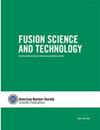高温加热核聚变产生的氚再处理固体废物的可能性
IF 1.2
4区 工程技术
Q3 NUCLEAR SCIENCE & TECHNOLOGY
引用次数: 0
摘要
本研究评估核聚变过程中氚产生的废物类型。评价了利用热处理技术对固体废物进行后处理和净化的几种方法,并比较了不同方法的优缺点。本研究选择的高温技术旨在用于欧盟DEMO项目,该项目用于处理核聚变反应产生的废物。对该技术的安全和环境问题进行了评估。对不同大小的固体废物的降解潜力进行了研究。这项研究的重点是主要由不同大小的钨尘颗粒组成的废物。研究了高温技术应用的可能性和基本原理。所进行的试验主要集中在各种气氛下粉末形式的钨废料上。讨论了金属和非金属的感应加热和熔化的相关问题。本文章由计算机程序翻译,如有差异,请以英文原文为准。
Possibilities of Reprocessing Solid Waste with Tritium from Fusion Using High-Temperature Heating
This study evaluates the types of waste generated by tritium during nuclear fusion. Some methods of reprocessing and decontaminating solid waste using thermal processes are evaluated, and the advantages and disadvantages of different methods are compared. The high-temperature technology selected for this study is intended for use in the EU DEMO project in the area where waste from nuclear fusion reactions is processed. Safety and environmental concerns around the technology are evaluated. The potential for detritiation of solid wastes of various sizes are investigated. The study’s focus is on wastes comprising mostly tungsten dust grains of various sizes. The possibilities and rationale for the use of high-temperature technologies are investigated. Tests conducted focus primarily on tungsten waste in powder form in various atmospheres. Problems related to the induction heating and melting of metals and nonmetals are addressed.
求助全文
通过发布文献求助,成功后即可免费获取论文全文。
去求助
来源期刊

Fusion Science and Technology
工程技术-核科学技术
CiteScore
2.00
自引率
11.10%
发文量
60
审稿时长
3 months
期刊介绍:
Fusion Science and Technology, a research journal of the American Nuclear Society, publishes original research and review papers on fusion plasma physics and plasma engineering, fusion nuclear technology and materials science, fusion plasma enabling science technology, fusion applications, and fusion design and systems studies.
 求助内容:
求助内容: 应助结果提醒方式:
应助结果提醒方式:


